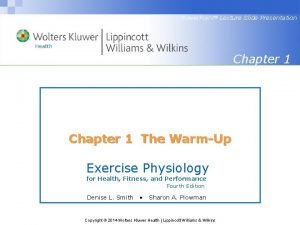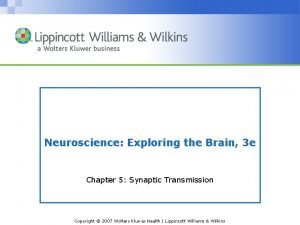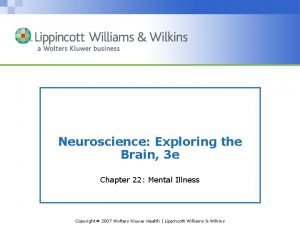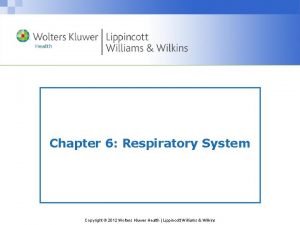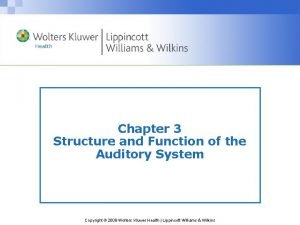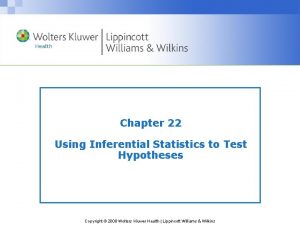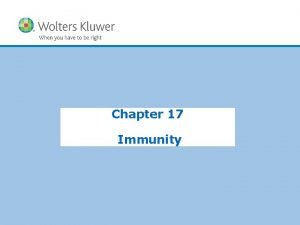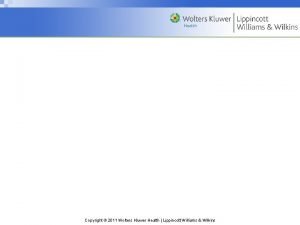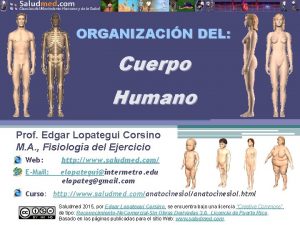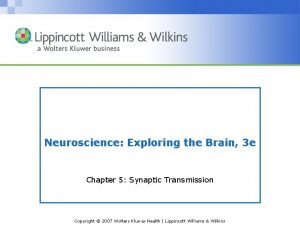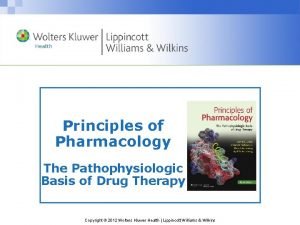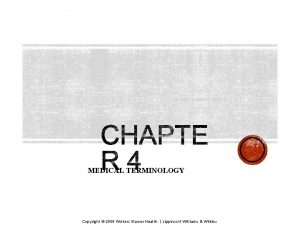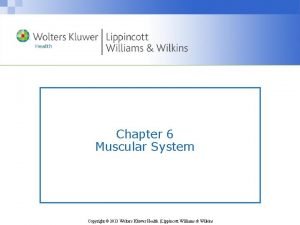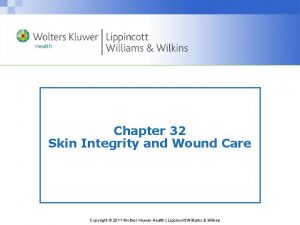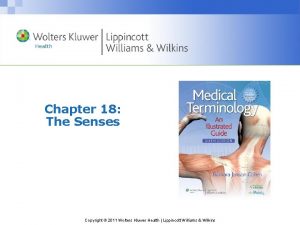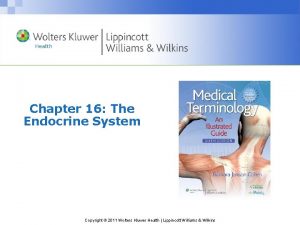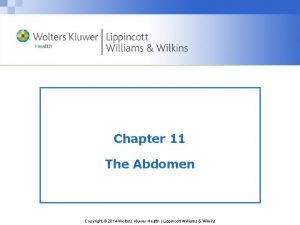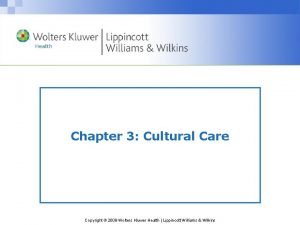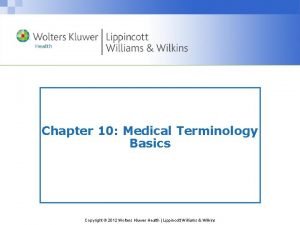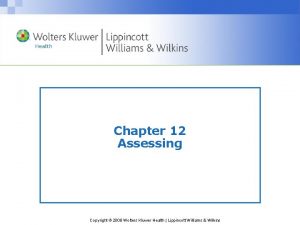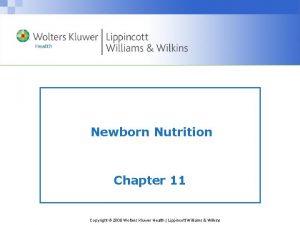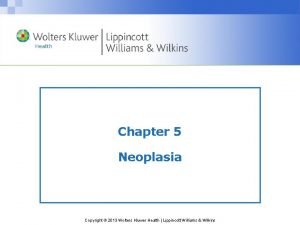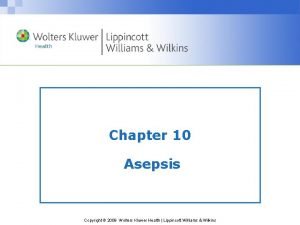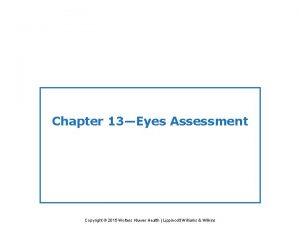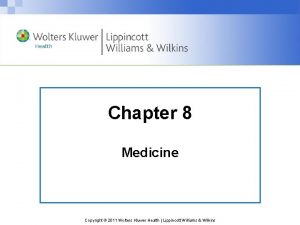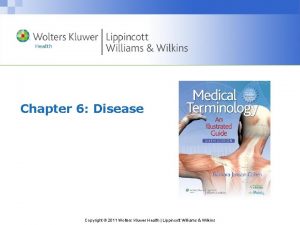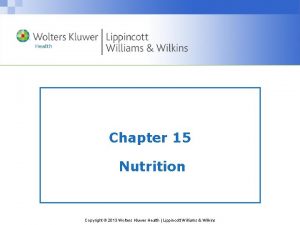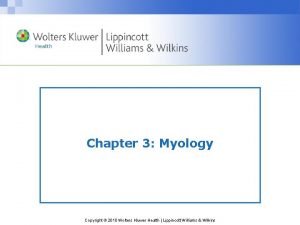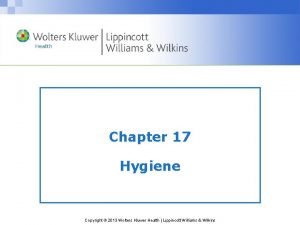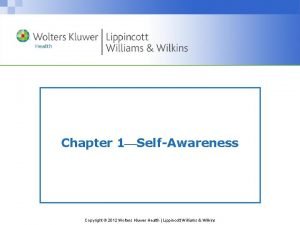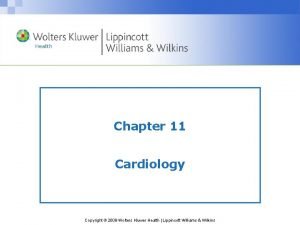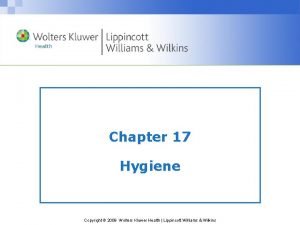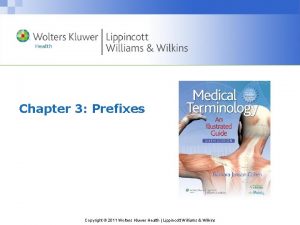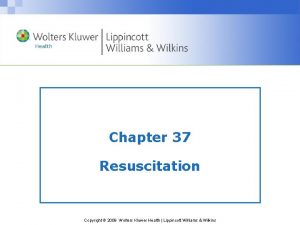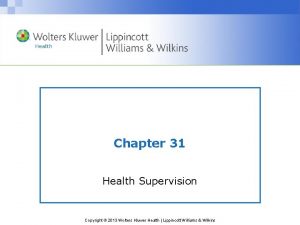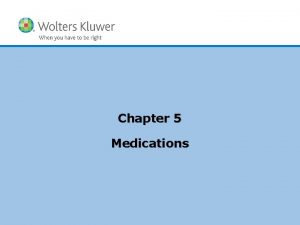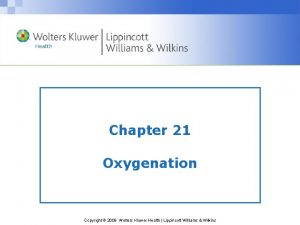Chapter 13 Diagnosing Copyright 2008 Wolters Kluwer Health

























- Slides: 25

Chapter 13 Diagnosing Copyright © 2008 Wolters Kluwer Health | Lippincott Williams & Wilkins

Purposes of the Diagnosing Step • Identify how an individual, group, or community responds to actual or potential health and life processes • Identify factors that contribute to, or cause, health problems (etiologies) • Identify resources or strengths upon which the individual, group, or community can draw to prevent or resolve problems Copyright © 2008 Wolters Kluwer Health | Lippincott Williams & Wilkins

Diagnosing Copyright © 2008 Wolters Kluwer Health | Lippincott Williams & Wilkins

Nursing Concerns and Responsibilities (Alfaro, 2004) • Monitoring for changes in health status • Promoting safety and preventing harm • Identifying and meeting learning needs • Promoting comfort and managing pain • Promoting health and well-being • Addressing problems that limit independence • Determining human responses Copyright © 2008 Wolters Kluwer Health | Lippincott Williams & Wilkins

Types of Diagnoses • Nursing diagnosis – Describes patient problems nurses can treat independently • Medical diagnosis – Describes problems for which the physician directs the primary treatment • Collaborative problems – Managed by using physician-prescribed and nursingprescribed interventions Copyright © 2008 Wolters Kluwer Health | Lippincott Williams & Wilkins

Collaborative Problems Copyright © 2008 Wolters Kluwer Health | Lippincott Williams & Wilkins

Four Steps of Data Interpretation and Analysis • Recognizing significant data – Comparing data to standards • Recognizing patterns or clusters • Identifying strengths and problems • Reaching conclusions Copyright © 2008 Wolters Kluwer Health | Lippincott Williams & Wilkins

Reaching Conclusions • No problem • Possible problem • Actual or potential nursing diagnosis • Clinical problem other than nursing diagnosis Copyright © 2008 Wolters Kluwer Health | Lippincott Williams & Wilkins

Formulation of Nursing Diagnoses • Problem—identifies what is unhealthy about patient • Etiology—identifies factors maintaining the unhealthy state • Defining characteristics—identifies the subjective and objective data that signal the existence of a problem Copyright © 2008 Wolters Kluwer Health | Lippincott Williams & Wilkins

Types of Nursing Diagnoses • Actual • Risk • Possible • Wellness • Syndrome Copyright © 2008 Wolters Kluwer Health | Lippincott Williams & Wilkins

Four Components of a Diagnosis • Label • Definition • Defining characteristics • Related factor Copyright © 2008 Wolters Kluwer Health | Lippincott Williams & Wilkins

Benefits of Nursing Diagnoses • Individualizing patient care • Defining domain of nursing to healthcare administrators, legislators, and providers • Seeking funding for nursing and reimbursement for nursing services Copyright © 2008 Wolters Kluwer Health | Lippincott Williams & Wilkins

Limitations of Nursing Diagnosis • If used incorrectly, patient might be “misdiagnosed” • Nursing practice might be restricted Copyright © 2008 Wolters Kluwer Health | Lippincott Williams & Wilkins

Sources of Error When Writing Nursing Diagnoses • Making legally inadvisable statements • Reversing the clauses • Identifying environmental factors rather than patient factors as the problem • Identifying as a patient response what is not necessarily unhealthful • Having both clauses say the same thing • Identifying as a patient problem what cannot be changed Copyright © 2008 Wolters Kluwer Health | Lippincott Williams & Wilkins

Common Sources of Error in Nursing Diagnoses • Premature diagnoses based on incomplete database • Erroneous diagnoses resulting from inaccurate or faulty database • Routine diagnoses resulting from failure to tailor data to patient • Errors of omission Copyright © 2008 Wolters Kluwer Health | Lippincott Williams & Wilkins

Question A patient who admits to smoking two packs of cigarettes a day is diagnosed with lung cancer based on his symptoms and a series of test results. Which of the following is the etiology in this scenario? A. Lung cancer B. Test results C. Smoking cigarettes D. The subjective and objective data Copyright © 2008 Wolters Kluwer Health | Lippincott Williams & Wilkins

Answer: C. Smoking cigarettes Rationale: The etiology is the factor that maintains the unhealthy condition (smoking cigarettes). Lung cancer is the problem, and the remaining factors are the distinguishing characteristics. Copyright © 2008 Wolters Kluwer Health | Lippincott Williams & Wilkins

Question A nurse decides that a patient has a possible problem with high blood pressure. During which step of data interpretation would this most like be determined? A. Recognizing significant data B. Recognizing patterns or clusters C. Identifying strengths and problems D. Reaching conclusions Copyright © 2008 Wolters Kluwer Health | Lippincott Williams & Wilkins

Answer: D. Reaching conclusions Rationale: A possible problem, such as high blood pressure, is diagnosed as a conclusion of data interpretation. Recognizing significant data refers to the comparison of data to a standard or norm (e. g. , normal blood pressure values). A data cluster is a grouping of patient data or cues that points to the existence of a problem (e. g. , a series of readings). The nurse must then identify strengths and problems and determine if the patient is motivated to address them. Copyright © 2008 Wolters Kluwer Health | Lippincott Williams & Wilkins

Question Tell whether the following statement is true or false. The nursing diagnosis: “Risk for Imbalanced Nutrition: Less Than Body Requirements” is an example of a risk diagnosis. A. True B. False Copyright © 2008 Wolters Kluwer Health | Lippincott Williams & Wilkins

Answer: B. False The nursing diagnosis: “Risk for Imbalanced Nutrition: Less Than Body Requirements” is an example of a potential diagnosis. Copyright © 2008 Wolters Kluwer Health | Lippincott Williams & Wilkins

Question Tell whether the following statement is true or false. A nursing diagnosis may be used to seek reimbursement for nursing services. A. True B. False Copyright © 2008 Wolters Kluwer Health | Lippincott Williams & Wilkins

Answer: A. True A nursing diagnosis may be used to seek reimbursement for nursing services. Copyright © 2008 Wolters Kluwer Health | Lippincott Williams & Wilkins

Question Which of the following nursing diagnoses is written correctly? A. Child Abuse related to maternal hostility B. Breast Cancer related to family history C. Deficient Knowledge related to alteration in diet D. Imbalanced Nutrition related to insufficient funds in meal budget Copyright © 2008 Wolters Kluwer Health | Lippincott Williams & Wilkins

Answer: D. Imbalanced Nutrition related to insufficient funds in meal budget Rationale: Answer A makes legally inadvisable statements, answer B is a medical diagnosis, and answer C reverses the clauses in the statement. Copyright © 2008 Wolters Kluwer Health | Lippincott Williams & Wilkins
 Wolters kluwer health
Wolters kluwer health Wolters kluwer health
Wolters kluwer health Wolters kluwer health
Wolters kluwer health Wolters kluwer
Wolters kluwer Wolters kluwer health
Wolters kluwer health Wolters kluwer
Wolters kluwer Wolters kluwer health
Wolters kluwer health Wolters kluwer
Wolters kluwer Wolters kluwer health lippincott williams & wilkins
Wolters kluwer health lippincott williams & wilkins Wolters kluwer
Wolters kluwer Wolters kluwer
Wolters kluwer Synaptic integration
Synaptic integration Wolters kluwer
Wolters kluwer Wolters kluwer
Wolters kluwer Chapter 25 assessment of cardiovascular function
Chapter 25 assessment of cardiovascular function Virchow's triad
Virchow's triad Wolters kluwer pronunciation
Wolters kluwer pronunciation Wolters kluwer
Wolters kluwer Wolters kluwer
Wolters kluwer Wolters kluwer
Wolters kluwer Wolters kluwer
Wolters kluwer Physical examination techniques
Physical examination techniques Wolters kluwer ovid
Wolters kluwer ovid Wolters kluwer culture
Wolters kluwer culture Wolters kluwer pronunciation
Wolters kluwer pronunciation 2008 2008
2008 2008
